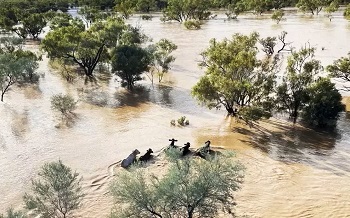In March 2025, Western Queensland experienced one of its most severe flooding events in decades due to a prolonged surface trough, intensified by La Niña conditions and the remnants of ex-Tropical Cyclone Dianne. Beginning around March 21, the region saw record-breaking rainfall, with some locations receiving more than a year’s worth of precipitation within a week. Rainfall totals exceeded 450 mm in areas, surpassing records from the 1974 floods.

Major river systems in the Channel Country—including Cooper Creek, and the Georgina and Diamantina Rivers—overflowed, inundating towns like Windorah, Jundah, and Stonehenge. The deluge caused widespread devastation: 18 people lost their lives, more than 15,000 residents were displaced, and damages were estimated at over $1.5 billion AUD. Agriculture was particularly hard-hit, with over 150,000 livestock lost and thousands of kilometers of fencing destroyed.
While the floods were disastrous, they also brought ecological benefits by rejuvenating parched floodplains, boosting aquatic ecosystems, and attracting large numbers of birds as waters flowed toward Lake Eyre.
In response, state and federal governments initiated emergency assistance, including evacuations, relief payments, and recovery funding. Despite these efforts, the event has prompted calls for improved disaster preparedness and infrastructure resilience, as climate variability increases the frequency and intensity of extreme weather events.
The Queensland Government is providing personal hardship financial assistance and a range of targeted local support services. Click here for full details.
Photo courtesy of David Batt.



